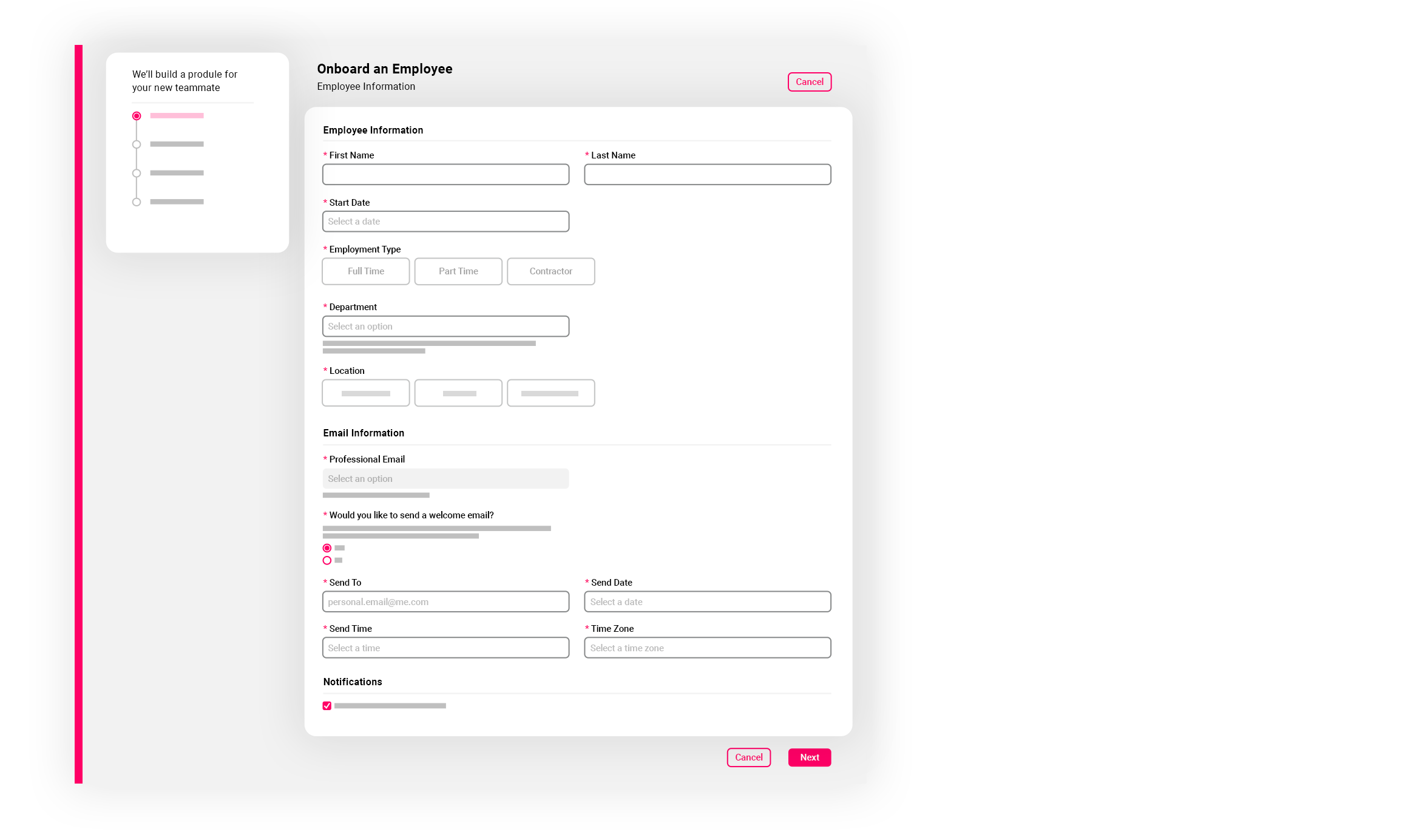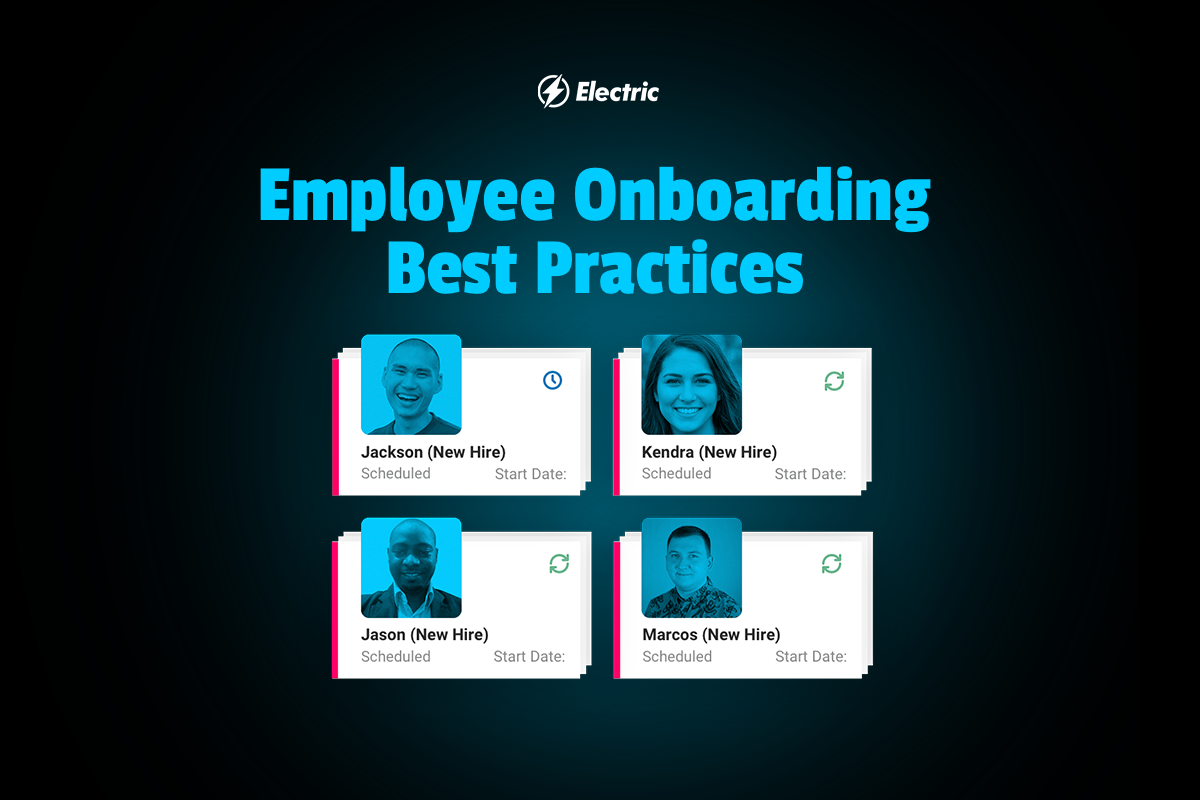
People are always joining an organization as part of the natural employee journey. While the circumstances for new hires can vary, it is important to ensure that these processes are well-defined within an organization so they go smoothly for all parties involved.
What happens after you’ve found the perfect candidate for a role? What happens when it’s time to welcome your new employee? What are you doing to set them up for success after they’ve been hired?
We’ve compiled our list of employee onboarding best practices below.
What Is Employee Onboarding?
Onboarding isn’t just a crucial process for employers to dot their i’s and cross their t’s, and it’s not just about saying “Welcome to our company!” In fact, employee onboarding is what sets either a strong or faulty foundation for new hires. An effective employee onboarding process makes a big difference, including increasing job satisfaction and productivity, lowering stress levels, and reducing turnover.
How Has Remote Work Impacted Employee Onboarding?
The pandemic has ushered in a “new normal” of social distancing, remote work, and meetings powered by video conferencing platforms. As the nature of management, recruitment and onboarding has changed, companies have been forced to adapt by developing new onboarding programs for incoming talent. Some new hires have only experienced very limited in-person interaction with managers or colleagues in the office; others have only ever met their coworkers over Zoom or Skype.
While necessary, such changes in the employee onboarding process have come with their share of challenges. The onboarding process is key to employee retention, and is thus a critical part of an organization’s overall recruitment and talent management strategy. What can you do to ensure that your remote employee onboarding program is a success?
6 Employee Onboarding Best Practices
The following information discusses the 6 best practices for employee onboardings, including how to do it remotely due to the pandemic. These suggestions will help make your new hires feel comfortable, equip them for their work duties, and ultimately enable them to thrive in their new position.
1. Implement a “Pre-Boarding” Process
While many job candidates have no issue with the online hiring process, they may begin to feel uneasy as the days until their first day of work countdown, and no one from the new employer has contacted them. Some new hires might even consider accepting other offers if they don’t hear from someone at the original hiring company between the day that they accepted the offer and their first day on the job.
The solution to this dilemma of unease can be referred to as “pre-boarding.” Simply put, the pre-boarding process is a way to put your new hire at ease by welcoming him or her to the company. This may involve sending a welcome email, offering some company “swag,” or even directly reaching out via phone, text, or Zoom. You can let them know who they’ll be working with, introduce them to members of the department, and give them info on whom to contact should questions arise.
Along with these employee onboarding considerations, you may want to send them important documentation even before their first official day, such as employee handbooks, culture decks, and your organization’s mission statement.
2. Make Sure Employees Have All Necessary Equipment
If your employees require specialized equipment in order to perform their work, make sure that they have that equipment on hand before their first day. This may require that you deliver the needed equipment several weeks in advance; that way, they’ll be able to get acclimated and won’t have such a steep learning curve on the job.
Of course, you’ll also need to ensure that your new hires have all of their required credentials in order. Their company accounts need to be set up, and they need to verify that they can log into those accounts. Make sure that they know which apps they’ll be expected to use, and have those downloaded onto the appropriate device. On the back end, you’ll also need to add them to any mailing list or other communication channel for their department and/or team.
Consider leveraging a solution like Electric to make the IT aspects of the remote onboarding process a breeze. In our employee onboarding platform, submitting an onboarding request takes a matter of minutes. Once your request is submitted, our team will handle the rest.This includes: 1) device provisioning & procurement; 2) application, software, & file access; and 3) credential management.
3. Ensure that All Resources are Accessible
You may also need to double check each new employee understands how to use important resources and access key information related to the onboarding and training process. For example, almost one-quarter of American workers are using online collaboration tools for the very first time. It may take some time for these workers to master even the basics of Zoom, or other video conferencing platforms.
In such a scenario, you need to ask yourself: What is this hire’s level of technical proficiency? Does he or she require more attention compared to other new employees? How can we best assist this employee to navigate the tools and programs required for the remote position?
4. Have a Clear Training Plan in Place
It’s no surprise that many new hires may have trouble staying focused during virtual training sessions. After all, there is almost always some distraction that arises around the home — and when small children are involved, all bets are off!
So as an onboarding best practice, have a solid training plan ready to go, then you can help your new hires to stay on target and learn what they need to learn in order to perform essential job activities. That being the case, your training program must be job-specific. Just as one example, a new hire in store support may need to understand policies around order fulfillment, product returns, and so forth, while an employee in sales will likely benefit from a deep dive into a featured product or service.
Additionally, it’s important to set clear expectations for progress at the start of the training process. If you provide new employees with a “roadmap” of the next few weeks, then they’ll be in a better position to gauge their own progress and make adjustments as needed.
5. Schedule Regular Feedback Sessions
When dealing with a 100% virtual work environment, it’s usually better to overcommunicate rather than under communicate, at least at the start. Driving this point home, one survey found that 72% of employees view one-on-one time with their direct manager as the most important aspect of any pre-boarding or onboarding process.
The point is, don’t be afraid to frequently “check in” with new hires. Schedule sessions between them and their teams, direct managers, and any other key players in their development. In addition, encourage them to ask questions and give feedback during these sessions as well. If you find that they are doing well and don’t require a lot of personalized management, then you can always pull back.
6. Assign New Hires a “Buddy”
New employees need attention, but their manager’s time and energy may be limited. One onboarding best practice that many companies have found to be most helpful is the implementation of an ambassador or “buddy” program. In other words, you may choose to assign a more experienced employee to mentor the new hire, and guide him or her through the onboarding process.
Why IT Makes a Difference in Employee Onboarding
So what does a seamless employee onboarding process actually look like? Sure, introducing new hires to everyone in the company and creating a special first day for them is important, but that’s not what’s going to help them do their job. What will help is effective IT support that gives them all the tools they need to get up and running.
That means setting new employees with a company email, making sure they have access to the necessary apps and accounts, and assigning them any appropriate devices. It also means making sure they understand company policies on passwords, cybersecurity, and, if applicable, on bringing their own devices. Keeping in mind that all of this should be done before they even set foot in the office.
Much of this may seem obvious, but even overlooking just one of these tasks will cause your new hire to struggle on the job; if they don’t know that they’re supposed to use a certain program, they won’t be able to ask, “What’s my account info?” in case you forget to give it to them.
The Employee Onboarding Checklist
You can download your own Employee Onboarding Checklist from Electric, but here are some of the general things to remember when onboarding a new employee. Not all of it may apply to the way your organization currently operates.
Get Situated
-
Create employee’s ID and ID card (if they are going to a physical office)
-
Provide access to building and office rooms
-
Verify that all employee information is correct
Set Up Accounts
-
Company email account e.g. Google or Outlook
-
Messaging apps e.g. Slack, Microsoft Teams
-
Password security tools e.g. LastPass
-
Productivity apps e.g. Asana
-
Analytics e.g. Google Analytics
-
VPN
-
Access to files/documents/training enablement tools e.g. Google Drive or Office365
Set Up Devices
-
Provision or re-provision devices
-
Install MDM (Mobile Device Management) and RMM (Remote Management & Monitoring) tools i.e. Jamf or Kaseya, ScreenConnect
-
Prepare to ship accessories and hardware (computer, mouse, keyboard, printer, phone)
-
Sign out necessary hardware (laptop, phone, cables, usb, etc.
-
Configure connection settings
-
Ship to new hires if they are remote
Schedule Appropriate Training
-
Cybersecurity policies(email security, password management, how to transfer data, etc.)
-
BYOD policies
-
How to use apps and programs required for their job
It helps to have a laid out process to onboard a new employee so nothing important is forgotten. It’s especially important to note any differences between departments, and may help to create separate checklists if that’s the case.
Automating the Employee Onboarding Process
Simply having formal onboarding processes doesn’t mean your company is carrying them out effectively. Manually onboarding employees can take hours to implement correctly. And what if you have to onboard several new people at once, for all different departments?
That’s why there’s the Electric Platform. With a few clicks, all of the most painful and often overlooked parts of onboarding are covered. For onboarding, this includes creating new emails for new hires, adding them to the appropriate Slack or Microsoft Teams channels, and creating accounts for the right apps. You can also manage company settings, set up preferences for each department to reduce redundancy, and schedule welcome emails for a new hire’s start date.

The Electric Platform can effectively streamline a formal onboarding process. All you need to do is plug in a few bits of info and the Electric Platform does the rest. It’s fast and secure for a stress-free transition. Contact us to learn more.



